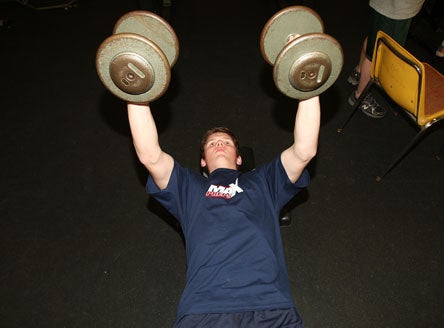
Doing lifts like the bench press can do harm to athletes who aren't strong enough, coordinated enough or experienced enough. Chin-ups, meanwhile, provide massive benefits and a simple concept.
Photo by Todd Shurtleff
One of the bigger challenges in scholastic strength and conditioning is working with first-time trainees who don't have all the necessary coordination to train as intensely as is required. As a strength and conditioning coach I've often come across this type of athlete and used to struggle with how I handled them. They're going to train, there's no way around that.
The easy way out is to stick the athlete on any machines that the school weight room might have access to and reason that it's safer for the individual. In all honesty, that's a result of the strength coach not wanting to provide the proper attention to the athlete.
Many high school weight rooms won't have enough machines, so what happens then? At this point the typical strength coach will put the athlete on a bench and make them press. Have you ever watched a beginner bench press? Even if they know the form, they look terrible and immediately flail, resulting in an unsafe training environment for the entire team.
Luckily a third alternative exists, the chin-up. Just about every high school weight room has a chin-up bar and just about every athlete struggles to do more chin ups. That gives the strength and conditioning coach an excellent opportunity to streamline the training session while helping athletes of every skill or experience level challenge themselves. The problem is that most athletes just can't do chin ups.
Here are a few simple steps for helping your athletes perform more chin-ups:
Do one more rep than you did last weekHave each athlete track their chin-ups from week to week, with their entire goal being to perform one more than they did the week before.
Perform partial repsEven if you can do only one chin-up or pull-up, get up there and do it. Now on the way down, stop halfway or a quarter of the way and pull yourself back up to the top. This will help to overcome a sticking point in the movement as well as increase your strength over about 10 to 15 percent of the range of motion.
Use slow negativesThis works better if you have a training partner that can help you go back up, but even if you train alone you should be using slow negatives. Say you can get about 4-6 reps. Slow your negative portion of the movement (when you go down) for a count of 3 going down. You'll activate more muscle to stabilize and lower your body than you would if you had just let your body fall down. If you have a training partner, have them spot you and force you back up when you can't pull yourself up.
While a young athlete may struggle with some of the more popular choices they can immediately jump up to the chin-up bar and start seeing results. Everyone wins when this happens and the athlete will build trust in your workouts.
So get up there and do pull-ups!
Jimmy Smith, MS, CSCS is a strength and conditioning coach and nutrition consultant based in Stamford, Conn. For more information visit his site at
jimmysmithtraining.com or his Facebook page at
facebook.com/physiqueformula.